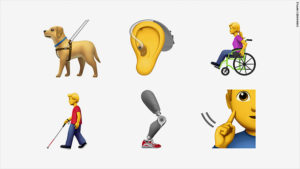I’m Ready For An Emoji That Represents My Disability
by Beth
I am completely blind. I can’t see emojis. The speech synthesizers on my laptop and phone describe them to me when they appear on screen, though. Want an example? Here’s a sampling of what I hear when choosing from the list of “Smileys and Other People” emojis:
- “Winking face with stuck-out tongue”
- “Smirking face”
- “Face with rolling eyes”
- “Flushed face”
- “Thinking face”

The emojis proposed by Apple
While researching this post I learned that members of the LGBTQ+ community have images representing them in emoji form — images of same sex families, two men holding hands, two women doing the same, rainbow flags. Cool! A couple of years ago I started noticing the speech synthesizer on my iPhone was calling out the skin tones of emojis, too. I follow Chance the Rapper on Twitter, and I smile any time he posts a tweet followed with something like “hands with medium skin tone pressed together.”
This increased representation is paramount to inclusion. But there is still work to do.
My research taught me there are 2,666 little images, symbols, or icons available to use in electronic communication, but guess how many represent people with disabilities?
One.
You read that right. More than 1 billion people worldwide have some form of disability, and one symbol – the image of a wheelchair – is meant to represent all of us.
Eyebrows up! That may change soon. The Unicode Consortium is discussing 13 new emojis to represent people with disabilities. In its submission to the Unicode Consortium, Apple wrote:
“Apple is requesting the addition of emoji to better represent individuals with disabilities. Currently, emoji provide a wide range of options, but may not represent the experiences of those with disabilities.”
I’ll say!
I’ve been using Twitter a lot more lately. Just last night I left a tweet to a local radio station that was interviewing author Robert Kurson, who has just come out with a book about space travel. My tweet mentioned that Kurson is also the author of “Crashing Through,” a book about a man who was blind and had some of his sight restored after experimental — and quite painful — medical treatments. I used so many characters to explain Crashing Through that I didn’t get a chance to mention that I, too, am blind. Imagine how many characters I’d save if I could just use the guide dog emoji. Or the one of a person walking with a white cane.
Thirteen new emojis have been suggested, everything from a man and a woman making the sign for “Deaf” to that one I mentioned above, the guide dog wearing a harness. Others depict people using canes, wheelchairs, and prosthetic limbs.
If these emojis are approved, they’ll be put on a shortlist of candidates for Emoji 12.0, due to be released in 2019. I say bring ‘em on. Maybe some day I’ll start ending my tweets with “happy person led by smiling guide dog in harness.”







June 8th, 2018 at 3:09 pm
Pls add and want to know ASAP.